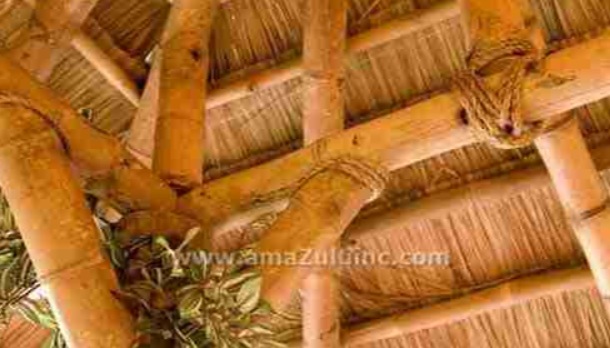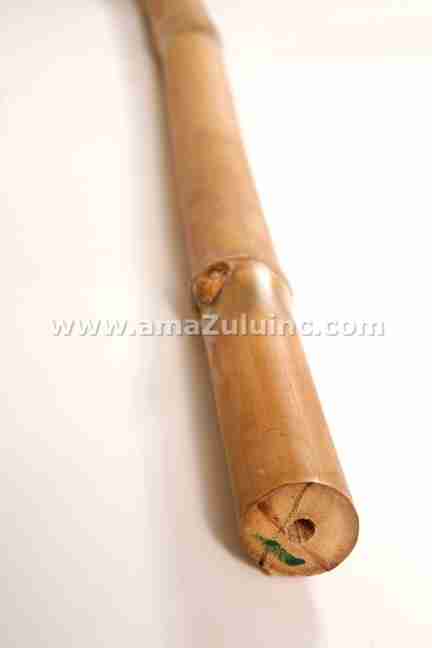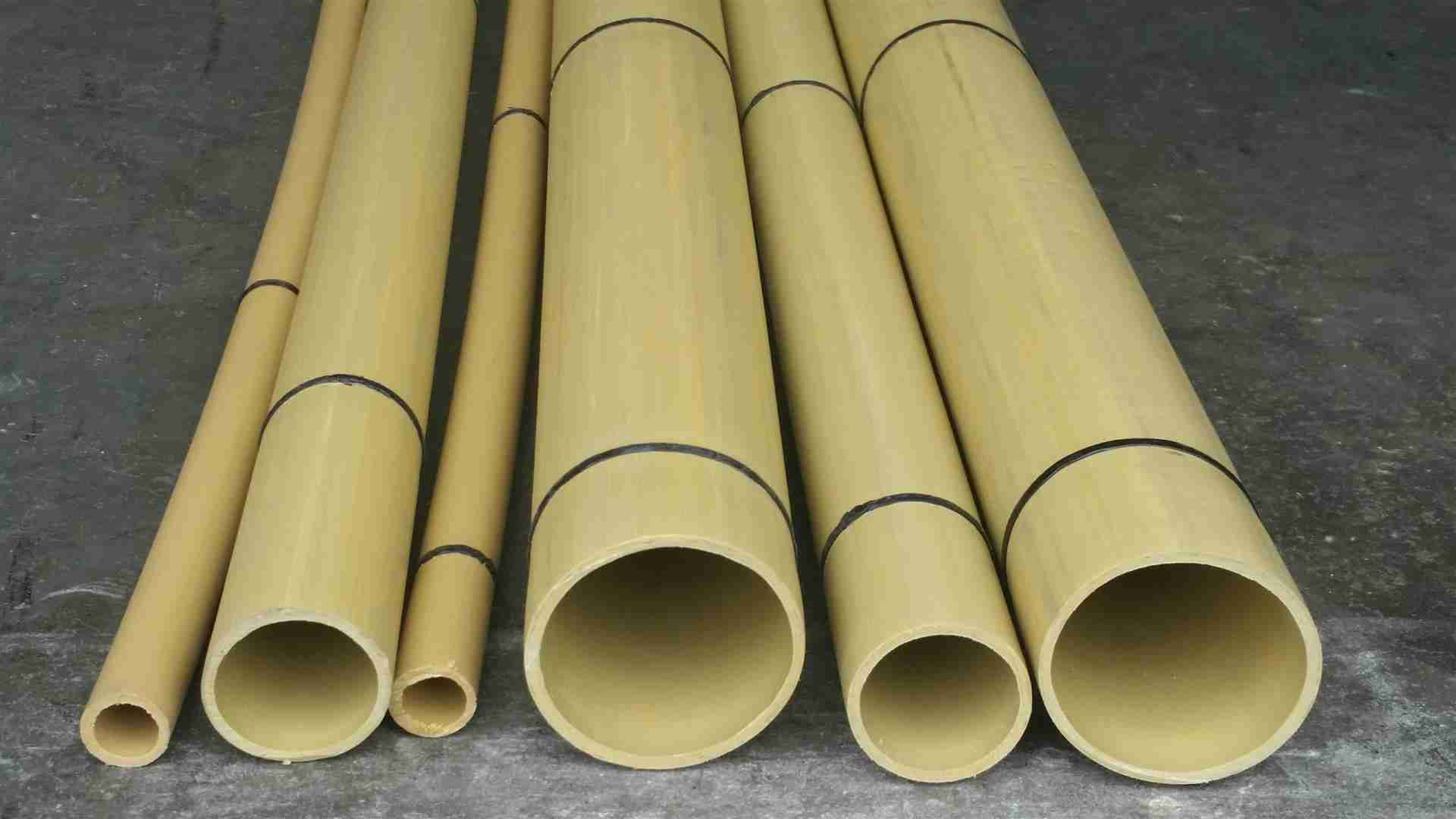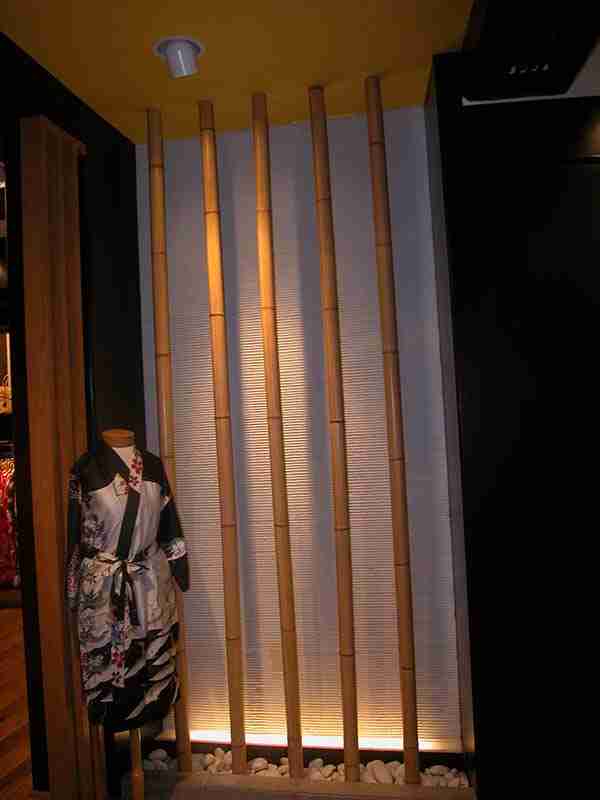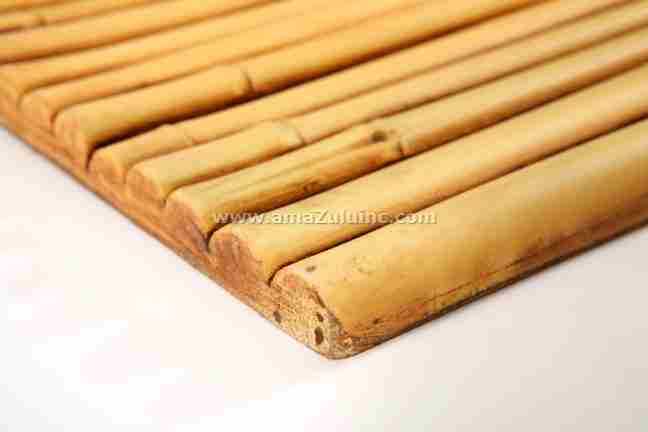From ancient Japanese gardens to modern tropical resorts, properly lashed bamboo structures are both functional and visually striking. A well-executed bamboo joint isn’t just about securing poles—it’s a hallmark of craftsmanship that defines the integrity of the design.
Bamboo lashing techniques transform simple poles into everything from garden trellises to elaborate commercial structures. Mastering these connections ensures durability, stability, and a professional finish.
Choosing the Right Lashing Materials
The materials used to lash bamboo poles together impact both structural integrity and aesthetics. Each option offers a unique combination of strength, weather resistance, and visual appeal—critical factors depending on your project’s environment.
Natural Fiber Lashings
- Manila rope – Strong and durable, with a classic look that ages beautifully. Ideal for indoor or covered outdoor spaces.
- Hemp cord – Water-resistant with a rustic appearance, offering moderate durability.
- Jute twine – Affordable but less resilient outdoors, making it best for temporary or decorative applications.
- Rattan strips – A traditional choice that seamlessly blends with bamboo, enhancing tropical aesthetics.
Synthetic Lashings
- Nylon cord – Extremely strong and weather-resistant, making it ideal for permanent outdoor structures.
- Polyester rope – UV-resistant and colorfast, maintaining its appearance even under harsh sun exposure.
- UV-resistant zip ties – A quick and secure option, often concealed with decorative coverings.
- Marine-grade cord – Specifically designed to withstand moisture and UV damage, ensuring longevity.
Metal Fastening Alternatives
- Stainless steel wire – Provides near-invisible reinforcement with superior strength.
- Copper wire – Strong with an attractive patina that develops over time.
- Decorative metal clamps – A modern alternative that adds a sleek, industrial touch.
Bamboo Lashing Techniques: A Quick Guide
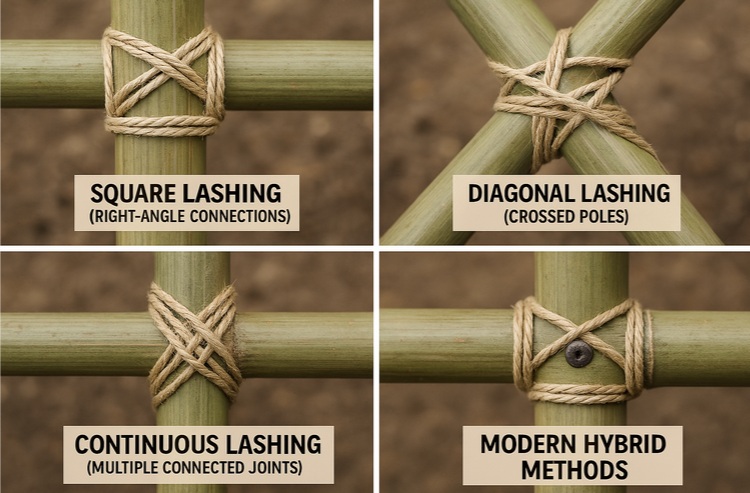
Bamboo lashing methods have evolved across cultures, each suited for different structural and decorative applications. The right technique ensures stability and longevity for your project.
Square Lashing (Right-Angle Connections)
Square lashing creates strong, stable joints when bamboo poles meet at 90-degree angles, perfect for furniture frames and structural supports.
Step-by-step process:
- Position your poles at a right angle where they need to connect
- Start with a clove hitch around the vertical pole, just below the horizontal pole
- Wrap the cord around both poles 3-4 times, passing between them in the same direction each time (these are the “wrapping turns”)
- Make 2-3 “frapping turns” by wrapping the cord between the poles, perpendicular to your wrapping turns, pulling tight to create tension
- Finish with another clove hitch on the vertical pole and trim excess cord
- For best results, ensure each turn lies neatly beside the previous one without overlapping
Diagonal Lashing (Crossed Poles)
Diagonal lashing secures bamboo poles that cross each other at angles other than 90 degrees, providing stability for structures like X-braces and reinforcements.
Step-by-step process:
- Cross your bamboo poles at the desired angle
- Start with a timber hitch around the crossing point
- Make 3-4 figure-eight wraps around both poles, passing through the center each time
- Create tension by making 2-3 frapping turns around the middle of your figure-eight wraps
- Secure the end with a square knot or another timber hitch
- For extra strength, ensure the figure-eight wraps are tight and evenly spaced on both sides of the crossing
Continuous Lashing (Multiple Connected Joints)
Continuous lashing efficiently connects multiple parallel poles to create screens, fences, or decorative panels with a clean, professional appearance.
Step-by-step process:
- Arrange your parallel bamboo poles at equal distances alongside perpendicular support poles
- Begin with a clove hitch on an end pole at the point where it meets the support
- Wrap the cord once around the support pole
- Continue to the next parallel pole and wrap once around the point where it meets the support
- Repeat this pattern for all poles, maintaining even tension throughout
- When you reach the last pole, reverse direction and return along the same path
- Complete at least 3 passes in each direction for stability
- Finish with a clove hitch and secure any excess cord
Modern Hybrid Methods
Hybrid lashing combines traditional techniques with contemporary materials to meet building codes while maintaining aesthetic appeal.
Step-by-step process:
- Pre-drill bamboo poles at connection points using a bamboo-specific drill bit
- Insert stainless steel bolts, screws, or threaded rods through the poles to create a solid structural connection
- Apply wood glue or epoxy suitable for bamboo at the joint for additional strength
- Cover the mechanical fasteners with decorative lashing using your choice of material
- Complete the lashing as you would with traditional methods, ensuring the decorative elements conceal all modern hardware
- Apply a protective finish to both the bamboo and lashing materials suitable for your installation environment
- For commercial installations, consult local building codes to ensure compliance while achieving the desired aesthetic
Tips for Professional-Looking Lashing Results
Regardless of which technique you choose, these best practices will ensure your bamboo connections look professional:
- Keep tension consistent throughout the entire lashing process
- Use appropriately sized cord for the bamboo diameter (generally 1/8 to 1/4 the diameter of your poles)
- Plan your lashing pattern before beginning, ensuring ends will be hidden from the most visible angles
- Practice complex joints on scrap pieces before attempting them on your finished project
- For outdoor applications, always choose weather-resistant materials and consider how they will age
- Apply a small amount of beeswax to natural fiber cord before lashing to improve longevity and water resistance
Troubleshooting and Maintenance for Bamboo Lashings
Regular inspections and maintenance help preserve the strength and appearance of bamboo lashings, preventing costly repairs or structural failures.
Signs of Failing Lashings:
- Loose or sagging connections
- Fraying, discoloration, or brittleness in natural fiber lashings
- Squeaking or movement under stress
- Mold or mildew growth on organic lashings
Preventative Maintenance:
- Apply a UV-protective coating to synthetic lashings exposed to sunlight
- Treat natural fiber lashings with oil-based preservatives annually
- Keep indoor bamboo structures away from high-humidity areas
- Check tension on major structural lashings seasonally
Common Fixes:
- Tighten loose lashings by adding extra frapping turns instead of redoing the entire connection
- Replace individual damaged sections rather than the entire lashing
- Reinforce aging connections with supplementary lashings
- Apply beeswax to natural lashings for added water resistance
When to Replace Lashings:
- When rot appears in bamboo at connection points
- If more than 30% of the lashing shows deterioration
- After severe weather events that may have stressed the structure
- When joints no longer feel secure
Project-Specific Lashing Applications
Garden Applications
Trellises & Arbors:
Garden trellises and arbors represent perfect entry-level projects for bamboo lashing. Their light load requirements allow for simple square lashing with natural fibers that age beautifully alongside climbing plants.
Structural Considerations
Load-Bearing Structures:
More substantial structures require robust connections. For pergolas or weight-bearing furniture, combining diagonal and square lashing with weather-resistant synthetics ensures longevity and safety.
Environmental Factors
Water Exposure:
Water features require special consideration due to moisture exposure. “Natural bamboo isn’t good where water is involved—it’s going to decay,” Tristan notes. “For water features, artificial bamboo is a better option.”
Design Applications
Interior Installations:
Interior design applications offer greater flexibility. Indoor bamboo elements can utilize decorative lashing patterns with colorful cords or refined natural fibers that become design elements themselves.
Commercial Settings:
Commercial installations must balance authentic appearance with commercial-grade durability. “You can use artificial bamboo to hide conduit and pipes,” Tristan says. In these environments, hybrid lashing ensures code compliance while delivering the immersive tropical experience customers expect.
Ready to Transform Your Space with Professional Bamboo Solutions?
While bamboo lashing offers endless creative possibilities, achieving professional-grade results requires the right materials, techniques, and expertise.
With over 22 years of experience in tropical building materials, amaZulu, Inc. provides high-quality natural and synthetic bamboo solutions tailored to your specific needs. Whether you’re building a backyard oasis or a large-scale commercial project, our team offers expert guidance, sustainable sourcing, and turnkey solutions to bring your vision to life.
Contact amaZulu today for personalized recommendations and premium bamboo materials designed to stand the test of time. Visit our website or call to get started on your next bamboo project with confidence.

